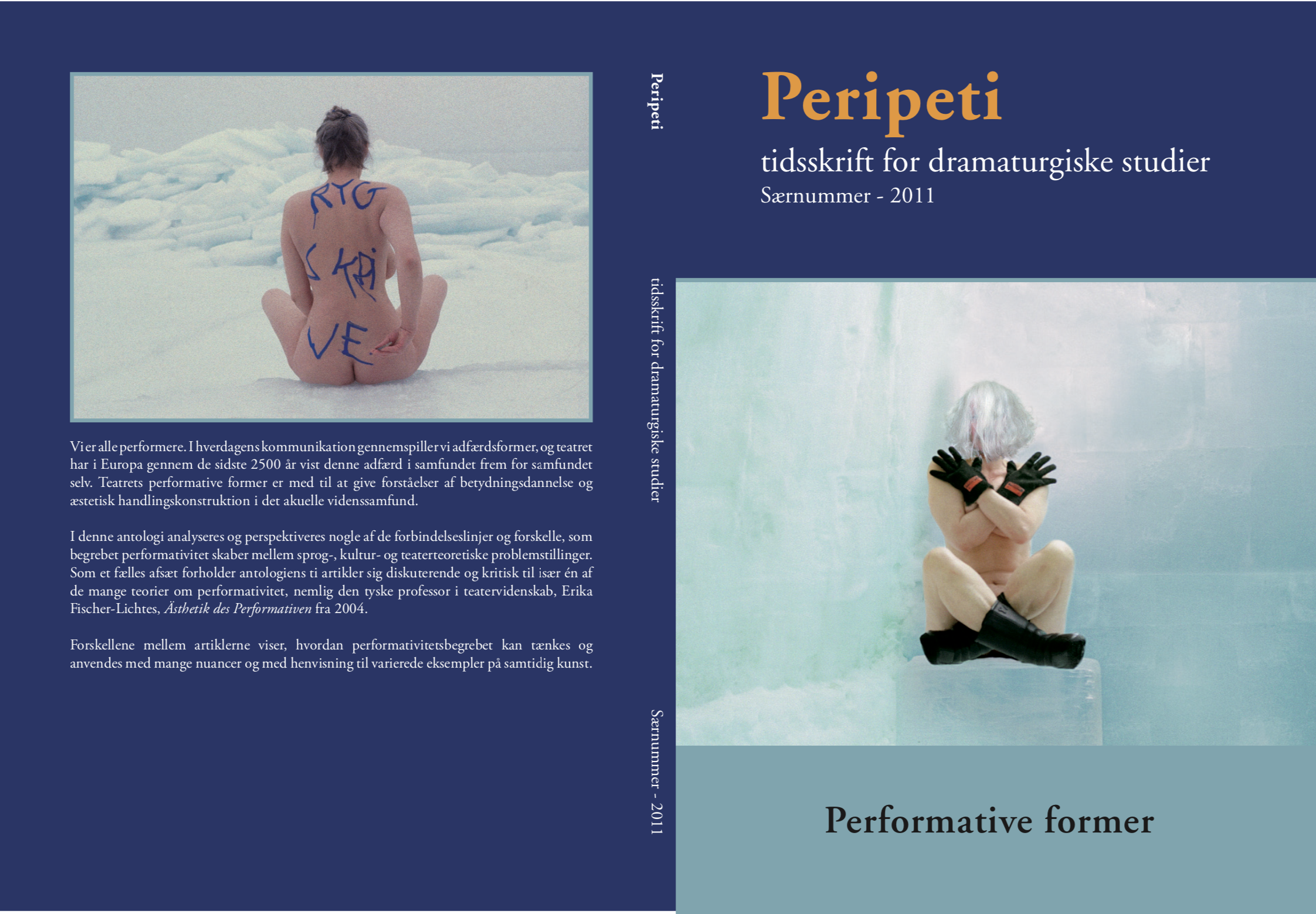En performers død.
Funus Imaginarium som genfortryllelse af teatrale former i 2010
DOI:
https://doi.org/10.7146/peri.v8iS3.110601Nøgleord:
Funus Imaginarium, genfortryllelse, performative ritualer, performativitetsteori, værkpoetikResumé
The grave as a place of being for the identity and the national citizen in Das Beckwerk’s political performance Funus Imaginarium (2010) disposes its focus like a mise en abyme construction on the consequence of the hunger artist’s theatricalised concept of authorship, which is expressed as the death of a performer. The mimed ritual of the performance expands the notion of the relationship between participant and spectator into a dance macabre of critical and tragic-comical character. Through Funus Imaginarium the notion of mimesis has re-enchanted the performance in a new political frame with reference to Sofocle’s Antigone and the Roman funeral ritual ceremony.
Referencer
Blau, Herbert: Take Up the Bodies: Theater at the Vanishing Point. (University of Illinois Press, Urbana, 1982).
Bleeker, M.: “Look who’s Looking!: Perspective and the Paradox of Postdramatic Subjectivity”, Theatre Research International, 29: 1, 2004, s. 29-41.
Eco, Umberto: “Det Åbne Værks Poetik.” in: Æstetiske Teorier: En Antologi, redigeret af Jørgen Dehs, (Odense Universitetsforlag, Odense, 1984), s. 101-24.
Essif, Les: Empty Figure on an Empty Space. Drama and Performance Studies, v. 13. (Indiana University Press, Bloomington and Indianapolis, 2001).
Fischer-Lichte, Erika: “Beyond the individual – the dead as the curse of the living – repeating the Ur-performance.” S. 298 ff in History of European Drama and Theatre. (Routledge, London and New York, 2002).
Fischer-Lichte, Erika: Ästhetik des Performativen. (Edition Suhrkamp, 2004).
Flower, Harriet I.: Ancestor Masks and Aristocratic Power in Roman Culture. (Clarendon Press, Oxford, 1996).
Fuchs, Ellinor: The Death of Character. (Indiana University Press, Bloomington and Indianapolis, 1996).
Herodian of Antioch’s: History of the Roman Empire. From the Death of Marcus Aurelius to the Accession of
Gordian III. Translated from the Greek by Edward C. Echols. (University of California Press, Berkeley & Los Angeles, 1961).
Iser, Wolfgang: “Tekstens appelstruktur” in: Værk og læser, redigeret af Michel Olsen m.fl. (Borgen, København,
1981), s. 102-33.
Kowzan, Tadeusz: “Art en abyme”. Diogenes. 24, 1976, s. 67-92
Nochlin, Linda: The Body in Pieces. The Fragment as a Metaphor of Modernity. (Thames and Hudson, London, 1994).
Rüpke, Jörg: “Triumphator and Ancestor Rituals between Symbolic Anthropology and Magic.” Numen: International
Review for the History of Religions, vol. 53, no. 3, 2006, s. 251-289.
Schneider, Rebecca: “Performance remains”, Performance Research, vol. 6, nr. 2, 2001, s. 100-108.
Sofokles: Antigone. Oversat af Otto Steen Due. (Aarhus Universitetsforlag, Aarhus, 2004).
Taylor, Diana: The Archive and the Repertoire. Performing Cultural Memory in the Americas. (Duke University Press, Durham, NC, 2003).
Worthen, William B.: “Antigone’s Bones”. TDR: The Drama Review, Volume 52, Number 3 (T 199) Fall, 2008, s. 10-33.
Downloads
Publiceret
Citation/Eksport
Nummer
Sektion
Licens
Det følgende vedrører alle Peripeti-udgivelser fra 2024, nr. 39, og senere:
Peripeti er et Diamond Open Access-tidsskrift, der giver direkte open acces til publiceret indhold ud fra princippet om, at det at gøre forskning frit tilgængelig for offentligheden understøtter en større global udveksling af viden.
Forfattere skal ikke betale for indsendelse, redigering eller offentliggørelse af artikler.
Forfattere, der bidrager til Peripeti, bevarer ophavsretten til deres artikler.
Forfattere accepterer at udgive artikler under en Creative Commons CC-BY-NC 4.0-licens. Vilkårene for denne licens tillader brugere frit at kopiere og videredistribuere materialet i ethvert medie eller format og at tilpasse, transformere og bygge videre på materialet, så længe der gives passende kreditering, et link til licensen gives, og eventuelle ændringer angives. Brugere må ikke dele eller tilpasse materialet til kommercielle formål uden samtykke fra licensgiveren. Brugen af licensen må ikke på nogen måde antyde, at licensgiveren støtter tredjeparten eller dennes brug. Licensen kan ikke tilbagekaldes.
Forfattere opfordres til at lægge deres artikler ud på personlige og/eller institutionelle hjemmesider for at sikre endnu større offentlig adgang efter udgivelsen. Forfattere har ret til at arkivere deres artikler i fondes og offentlige institutioners arkiver, men Peripeti anmoder om, at forfattere bruger et direkte link til den publicerede artikel på tidsskriftets hjemmeside, når det er muligt, da Peripeti som en ikke-kommerciel, offentligt finansieret udgiver er afhængig af niveauet af brugeraktivitet på tidsskriftets hjemmeside.
Vedrørende tidligere udgivelser, indtil 2024, herunder nr. 38:
Ophavsretten deles mellem Peripeti og forfatteren/forfatterne. Tidsskriftet er et open access-tidsskrift, der giver direkte adgang til alt indhold baseret på princippet om, at det at gøre forskning frit tilgængelig for offentligheden understøtter en større global udveksling af viden. Brugere kan frit kopiere og dele materiale i ethvert medie eller format, så længe der gives passende kreditering. Enhver anden brug kræver skriftligt samtykke fra indehaverne af ophavsretten.





